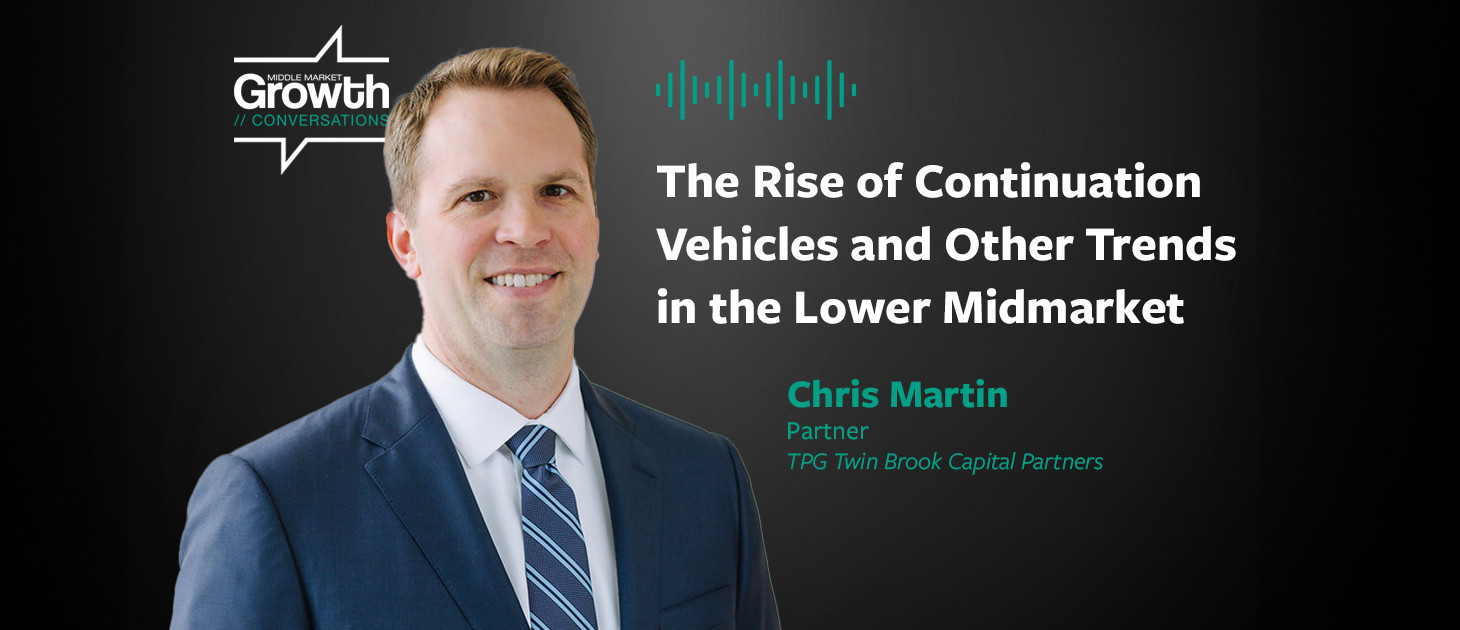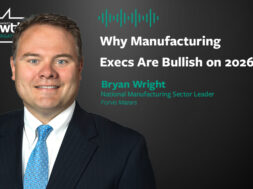The Rise of Continuation Vehicles and Other Trends in the Lower Midmarket
TPG Twin Brook Capital Partners joins Conversations to share the latest in lower middle-market M&A

From continuation vehicles to tariff impacts, from lending structures to interest rates, what are the biggest trends shaping M&A in the lower middle market? Chris Martin, partner with TPG Twin Brook Capital Partners, joins the podcast to talk about the latest developments, including the ascent of continuation vehicles and direct lending.
This episode is brought to you by TPG Twin Brook Capital Partners, a leading direct lending finance company focused on providing cash-flow based financing solutions for the middle-market private equity community. To learn more about TPG Twin Brook, visit www.twincp.com.
Read a transcript of the conversation below.
Middle Market Growth: Welcome to Middle Market Growth Conversations, a podcast for dealmakers discussing the trends shaping the middle market. I’m your host, Carolyn Vallejo, and this is a production of the Association for Corporate Growth. Today we’re sitting down with Chris Martin, partner with TPG Twin Brook Capital Partners, to talk about developing trends in the lower middle market, including the ascent of continuation vehicles and direct lending. Now, it’s been a few years since you were last on the podcast. Welcome back, but let’s take some time to let our listeners get to know you once again. Can you tell us a bit about your role at TPG Twin Brook?
Chris Martin: Hey, Carolyn. Thanks for having me. TPG Twin Brook is a direct lender in the lower middle market serving private equity clients. We specialize in providing one-stop financing solutions, meaning we are primarily the only tranche of debt on a company. Having a one-stop financing solution provides certainty of execution and speed to close, which is critically important to clients trying to differentiate themselves to the businesses they’re partnering with. And my role at the firm is on the origination side, which means I’m typically the direct point of contact between our firm and the private equity clients. And when they’re looking for financing on a business that they’re interested in pursuing, they’ll reach out and we’ll start evaluating the opportunity.
MMG: Excellent. And just for a little bit of fun, we ask all of our guests this at the top: What was your first job that you ever had, and was there any lifelong lesson that maybe you took from it?
CM: I guess my first real job started when I was about 12 years old, mowing lawns in my neighborhood, which sounds pretty easy and vanilla. But growing up in the northeast, I was constantly dealing with hilly and rocky lawns that would take way longer to finish than they should have. It took me a long time to figure out that bringing along a couple of friends made the job a lot easier and quicker, so I guess that was my first lesson in teamwork, something that certainly applies to professional life. So, I guess a good takeaway is that an effective team could make a job a lot more enjoyable.
MMG: Yeah, that’s a great point. All right, let’s get down to the main topic of conversation today. Tell me what are the defining factors of today’s lower midmarket?
CM: Most people think of lower middle market as just EBITDA size, and that’s often how it’s defined, but your stereotypical lower middle-market businesses, founder-owned with less than $25 million of EBITDA so, these businesses are often in market looking for their first institutional capital partner. And this can be across a wide range of industries. I typically focus on business services, distribution businesses, industrial and some consumer services, and they’re looking for a partner to help them professionalize a company and take it to the next phase of growth. And that can be a whole host of initiatives including investing in new management sales staff, marketing, improving internal reporting systems, and transforming the business for the next phase of growth.
MMG: It’s been, let’s say, an interesting economy the last few years, to say the least—rising interest rates, tariffs, lots of change, a lot of uncertainty. What are some of the macroeconomic trends that continue to impact deal activity in the lower middle market?
CM: There’s a lot to consider there. I guess if you look back at the macro backdrop over the last five years since COVID, each year it feels like there’s been something new that you need to pay attention to. Some macro events have had a significant impact on deal activity in all aspects of the market, not just a specific industry. I would say the most significant impact was the spike in interest rates and inflation in 2022 and 2023, which led to a significant slowdown in M&A volumes as people were preparing for potential recession, which never came to light, but it’s certainly made it very difficult for a lot of businesses to properly budget and forecast their cash flow and try and figure out what the next year would bring. So, that’s been a major topic for a long period of time. And then in April came tariffs, which brought a whole new host of issues, which we haven’t really gotten through yet. So, right now that’s really what people are focusing on. So yeah, it’s impacted the lower middle market pretty significantly in the sense of if you have tariff exposure, it’s really hard to predict exactly what the impact is going to be. And those businesses are probably on the sidelines at the moment, and it’s affecting deal volume. But businesses that are domestic and relatively insulated from these cost increases are getting a lot of attention and certainly there’s good opportunities for them to come to market.
MMG: Right, there certainly are good opportunities, as you say, but deal origination has been sluggish, especially when compared to the boom of 2021. Dealmakers have had to get creative when it comes to finding and deploying capital. So, can you tell me about what you’re seeing there in terms of some interesting ways these dealmakers are dealing with that challenge?
CM: We think of it more of as a supply issue where companies are waiting for the right time to come to market, and there certainly is good opportunity for the right businesses to find a partner. There’s capital available both on the debt side and the equity side, so conditions are pretty good there. And I think coming into 2025, we were really looking at a good environment for that and tariffs essentially put that on a bit of a pause so that’s what people are waiting for, is the right moment to come back out. But in the meantime, you have to get creative to find deal flow. And that means approaching businesses that are on the fence about coming to market, potentially looking at portfolio companies of private equity funds, and that’s where we’re really finding a lot of success. I mean, there’s a lot of businesses out there that have been waiting two, three years beyond what they would normally do before they come to market. And we found good opportunities to approach them about a potential refinance or extending the duration of their existing facilities to allow them the time to execute on their plan and be in a better position to take it to market when conditions are a little bit better for an exit.
MMG: I want to talk for a moment about covenant lite lending. Can you tell me about the risks and drawbacks of this type of financing and how they can potentially be addressed or mitigated?
CM: Yeah, ultimately, cov lite means there’s no financial test on the business after you close. So, you’ve got some other protections there, but essentially if a company deteriorates, if earnings decline, you’re not going to have a seat at the table unless there’s some sort of payment default or bankruptcy. So, it’s a much different product and typically a different size of business than we typically see, but ultimately, you’re closing a deal on day one and then kind of setting it on the shelf and hoping things work out. So, for us, that’s not really our strategy or something that we participate in. We’re much more hands-on. We require financial covenants in every transaction that we do, and we find that if there’s an issue that’ll get us to the table, to a point where we can have a realistic conversation with an owner and the management team about where the business is and where it’s going and how to course correct and get it on better footing.
MMG: In a market like the one we are in right now, where there is so much continuing uncertainty, lending structures have become increasingly important, and the direct lending market has now reached $1.4 trillion. I mean, this is huge. There’s more competition, which can lead to looser deal terms. Can you tell me some investment practices that lenders really should be keeping in mind in a market like today’s?
CM: The private equity community continues to rely heavily on direct lending providers for their financing solutions, replacing what was traditionally commercial banking lenders and the syndicated loan market for financing M&A. The ability to respond quickly and to provide incremental capital for acquisition financing is a key differentiator for lenders. And as direct lenders such as TPG Twin Brook have increased their capital base and their hold size, sponsors have gotten comfortable relying on direct lenders like us for financing needs down the road and not just the day it closes.
Ultimately, first and foremost, in the lower middle market, we typically put less leverage on these businesses. They’re a little bit younger in their evolution, as I mentioned, A lot of times it’s first-time institutional capital. So, ultimately that’s the key factor for a lot of these businesses is how much risk are you putting on, or how much pressure you putting on the cash flows from a leverage standpoint. So, we take a fairly conservative approach to that relative to the upper market. And I think that’s one of the key differentiators. We spend a lot of our time evaluating, stress testing the companies and evaluating the structures to figure out just where the business needs to be and the conditions that need to be put on a company and on a structure. And that’s our approach to it. And we’ve stuck with that over many, many years.
MMG: We’re also seeing that continuation vehicles are on the rise, and I know that TPG Twin Brook closed a $3 billion fund, which is quite impressive. What trends are you observing around CVs and their appeal to borrowers?
CM: The way we see it is that continuation vehicles are becoming an essential tool for investors. It reflects a need for flexibility and managing longer asset durations and providing additional liquidity to investors. And we view them as a strategic tool for sponsors to retain value, manage their duration, and create optionality for investors. So, oftentimes there’s more work to do from a strategic standpoint and from a management standpoint, but some investors need to have a return of capital. So, CVs allow that optionality. Sometimes investors want to continue with the business and other times they want to exit. And CVs are essentially a tool for that, where somebody can make a choice as to whether or not they want to continue. And if a sponsor feels like the right thing for the business is to give it more time, essentially, it’s what CVS provide that’s critically important. So, in a macro environment where traditional M&A volumes have been impacted by the global events that we talked about, these CVs and refinancings are a great new source of deal volume for direct lenders that can augment a slower M&A cycle. So, we continue to find ways to support sponsors as they adapt, and CVs are just one of those avenues.
MMG: All right, well, dealmakers always want to know what’s ahead. So, looking out towards the next, say, six to 12 months, what are some of the macro factors that you will be monitoring most closely? What is your outlook for the direct lending market?
CM: I think we’re right on the edge of a lot of good deal activity. So, as I mentioned, there’s a backlog of businesses that want to come to market. They just need to find the right environment. So, certainly tariffs and interest rate policy [are some] of the key external factors that people are looking at. You’ve got a Fed environment where interest rates might be going down again, TBD on that. But essentially, I think if people can find some earning stability and comfort in some of the costs of the businesses that will be affected by inflation such as tariffs or labor inflation, I think those are the key factors in whether or not we’re going to see a big surge in exits here. So, if you ask me to prognosticate the next six to 12 months, I think it should be a much better deal environment. We are sitting here in September faced with definitely some uncertainties as to what inflation looks like ahead, but certainly there’s growing confidence that it’s under control and that businesses can come to market with a lot of conviction around their earnings and strategic positioning in their markets. So, I guess if you’re going to put me on the spot, I would say the next six to 12 months should be a good M&A environment for groups like TPG Twin Brook.
MMG: Okay, a positive outlook, we love to hear it. Chris Martin with TPG Twin Brook Capital Partners, thank you so much for joining the Conversations podcast.
CM: Great, thank you.
This transcript was prepared by a transcription service. This version may not be in its final form and may be updated.
The Middle Market Growth Conversations podcast is produced by the Association for Corporate Growth. To hear more interviews with middle-market influencers, subscribe to the Middle Market Growth Conversations podcast on Apple Podcasts, Spotify and Soundcloud.


